Five Lessons For Understanding This Market
I ended last week's missive with the words, "So, from my seat, some caution remains warranted." Silly me. What was I thinking?
To be honest, I was thinking that the market's recent joyride to the upside, which, as of Friday, has produced gains of 42.8% from the low on the S&P 500, 45.8% on the DJIA, 40.5% on the NASDAQ 100, 50.3% on the IWM (Russell 2000 Small Cap ETF), and an eye-popping 57.8% on the MDY (SPDR S&P 400 Midcap ETF), was getting a little frothy. No, let's make that a lot frothy.
The S&P responded to my cautious tone with a remarkable gain of +4.9% on the week. Don't look now fans, but the venerable blue chip index is now just 5.7% from its all-time high and is off a mere 1.14% on the year (0.26% when dividends are reinvested). So again, silly me.
Virus? What virus? We're moving on. The worst recession, maybe, ever? No worries! Twenty million unemployed? It doesn't matter, those job losses are temporary, right! The Administration renewing its fight with China? Ignore it. Unrest in the streets? Wall Street hasn't noticed.
If It's Obvious...
Given the plethora of worries, concerns, and fears out there, I guess my idea that some caution might be warranted after a monster run was, in a word, obvious. But as the late Joe (I'm The Greatest) Granville was famous for saying, "If it's obvious, it's obviously wrong!"
Clearly Friday's jobs report, which surprised to the upside and represented the biggest "miss" of all-time added fuel to the stock market's fire. Many analysts were quick to suggest that the stock market had been "sniffing out" the turnaround in the job market and thus, has been "right all along.
So, a point I'd like to make on this fine Monday morning is that it is SOOO easy to succumb to consensus thinking about what is happening during times like these. It's natural to say, hey, things are terrible, so stocks should go lower, not higher. Just look how bad the data is!
But - and I know this concept is tough to deal with at times - we must remind ourselves that stocks don't trade based on what is happening right now. No, everybody join in now... "Stocks are a discounting mechanism of future expectations." This means that the market has already "baked in" the bad news that you may be seeing now. So, when stocks are moving in the opposite direction of the news, it means that traders are looking ahead (and not back).
Up until Friday, this seemed like a stretch. As in a BIG stretch. One of the primary narratives in the market was the purported "disconnect" between Wall Street and Main Street. While the economy is experiencing perhaps the worst hit ever and according to the WSJ, 80% of those surveyed feel America is "spiraling out of control," the stock market has been dancing merrily higher. So, what gives?
I've been managing other people's money in the markets since 1987 and I like to think that I've learned a thing or two along the way. As such, this morning, I'd like to review a few of the lessons I've learned about investing that have helped me come to grips with this market.
Lesson 1: Buy When The Recession Is Official...
The first lesson relates to recessions. The rule is that a buy signal occurs when the government officially declares a recession. The idea is that by the time the data shows the economy is actually in a recession, the recession is probably over or, at the very least, closer to the end than the beginning. And since according to the computers at Ned Davis Research, a healthy chunk of a bull market's gains (approximately half) tend to occur in the first one-third of the bull market's duration, it tends to pay to get invested early.
Granted, the National Bureau of Economic Research (the keeper of the recession/expansion data) has yet to officially declare that the U.S. is in recession. However, I believe we can still apply the lesson here because just about everybody on the plant will agree that we've got a recession going. And this view started to gain traction in April, along with the stock market rally.
Lesson 2: Buy When There Is "Blood In The Street"
The second lesson is to "buy when there is blood in the street" (as in Wall Street). This is a take off on one of Warren Buffett's rules of investing, which is to be "fearful when others are greedy and greedy when others are fearful." And since the news over the past two months has been nothing short of scary, it makes sense that traders would be looking to buy when unemployment hit record levels and economists were busy fighting over whether GDP would be down 30% or 50% in Q2.
To be sure, there was plenty of "blood" flowing in the stock market between February 19 and March 23. As such, it isn't surprising that professional investors were trying and take advantage of the carnage. For example, even yours truly was upping equity exposure in client accounts on March 23 and March 24.
But since the early days of April, it has been tough to "get in." In fact, the best the bears have been able to do since the bottom has been a two-day pullback. Oh, and there have only been four of those!
Lesson 3: Don't Fight The Fed
Another very big lesson - a lesson that seems to gain importance with each and every market crisis - is, "Don't Fight the Fed."
However, this time around, it felt like the Fed was helpless against the novel coronavirus. I was on record early in the crisis opining that the Fed couldn't fix this, only science could. Again, silly me.
You see, that was before QE4EVER began. Before the Fed changed the rules of the game and started buying securities they'd never bought before (and aren't even legally allowed to buy). Before, the alphabet soup of new programs to make sure that liquidity flowed. And before Jay Powell went on 60 Minutes and pronounced that there is "no limit" to the amount of support the Fed can provide.
One thing traders have learned since the Financial Crisis is to "shake hands with the Fed/Government." In other words, when the Fed is buying and the Government is dropping money from helicopters, you need to be buying.
Lesson 4: Money Goes Where It Is Treated Best
While on the subject of central bankers, money printing, and managed economies/markets, there is yet another lesson to review. In short, it is important to recognize that we play in a global financial system these days and that money goes where it is treated best.
A big lesson learned after Financial Crisis is that when global central bankers are all playing the QE card, a healthy amount of the newly minted cash (well, digitally minted currency, that is) winds up in the U.S. stock and bond market.
Why? Because the U.S. is the best game in town. The best bad house in the neighborhood during a crisis. The market where the big tech winners reside, which are up nicely in the face of the virus. Oh, and the only country with government bond rates that are still positive.
Therefore, money continues to flow into the U.S. stock market. Period.
Lesson 5: TINA
The last lesson worth remembering is summed up in the acronym T.I.N.A. There is no alternative. And I for one, believe this lesson applies here, big time.
Think about it. Where else are investors going to put money in a COVID world besides the U.S. stock and bond markets? Office buildings? Uh no. Apartments? Not a chance. Shopping Malls? Nope. Rental properties? A hard no. Mortgages? Please. Commodities? Heck no. Restaurants? Be serious. Gold? Okay, maybe. (But those bars are heavy and you have to put 'em somewhere!) I could go on, but you get the idea.
The key is that the U.S. stock market continues to be one of the primary investing vehicles on the planet. And money simply continues to flow in. For example, I'd be willing to bet dollars to donuts that at least a portion of your 401K contribution goes into the U.S. stock market. Every month. Like clockwork.
And guess what, when those contributions come in to all those index funds that 401K sponsors love so much, that money has to be invested. As in immediately. Those managers aren't looking for the best opportunity to buy. No, they need that money in the market - now.
The point is that until there is a decent alternative for investors everywhere, money is going to continue to flow into the market. It's that simple. As such, remember that there is ongoing demand for stocks. And of course, that's before the buybacks...
Finally, To Clarify...
And finally, I'd like to clarify last week's comments urging some caution. My thinking wasn't that it was time to raise some cash. No, it was more related to the idea that the market had come a LONG way and that it might be time for a rest - so we should be ready. After all, I've read that the S&P 500 has put in the best gain over a 50+ day period in history. So, from my seat, I felt the odds were growing that something bad might come out of the woodwork. But, one more time, silly me!
Weekly Market Model Review
Each week we do a disciplined, deep dive into our key market indicators and models. The overall goal of this exercise is to (a) remove emotion from the investment process, (b) stay "in tune" with the primary market cycles, and (c) remain cognizant of the risk/reward environment.
The Major Market Models
We start with six of our favorite long-term market models. These models are designed to help determine the "state" of the overall market.
There are two changes to report on the Primary Cycle board this week. First the Leading Indicators Model improved from negative to neutral and is now just a hair away from a new buy signal. In addition, our Desert Island Modal also moved out of the red and into the neutral zone. And finally, it is worth noting that although there is only one buy signal on the board, there are no longer any sell signals and the average historical return improved from 0.9% to 11.4%. As such, I think we have to upgrade the status of the Primary Cycle board to moderately positive.
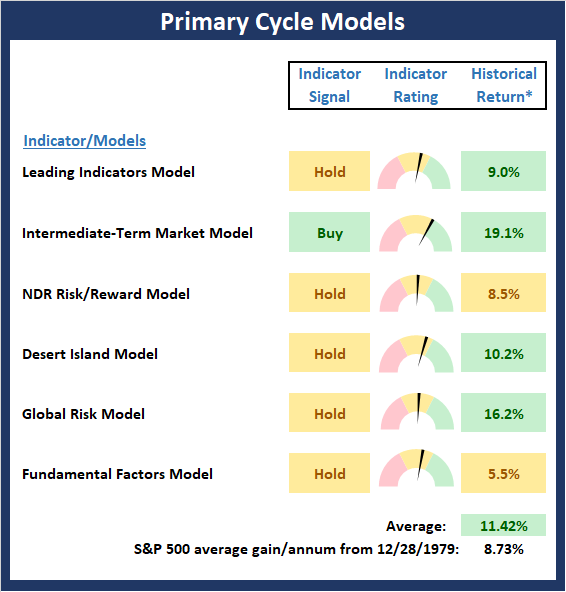
* Source: Ned Davis Research (NDR) as of the date of publication. Historical returns are hypothetical average annual performances calculated by NDR. Past performances do not guarantee future results or profitability - NOT INDIVIDUAL INVESTMENT ADVICE.
View My Favorite Market Models Online
The State of the Fundamental Backdrop
Next, we review the market's fundamental factors in the areas of interest rates, the economy, inflation, and valuations.
Once again, there are no changes to the Fundamental Factors board this week. This too can be considered moderately positive.
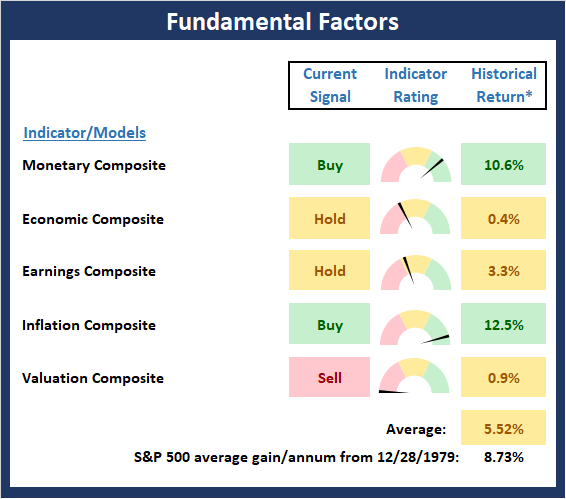
* Source: Ned Davis Research (NDR) as of the date of publication. Historical returns are hypothetical average annual performances calculated by NDR. Past performances do not guarantee future results or profitability - NOT INDIVIDUAL INVESTMENT ADVICE.
View Fundamental Indicator Board Online
The State of the Trend
After looking at the big-picture models and the fundamental backdrop, I like to look at the state of the trend. This board of indicators is designed to tell us about the overall technical health of the current trend.
After the best run over a 50-day period in history, it isn't surprising to see an awful lot of green on the Price Trend board. In addition, our shorter-term "Trading Regime" model moved from mean reverting to trending. As such, investors should give the bulls the benefit of any doubt during the next inevitable pullback.
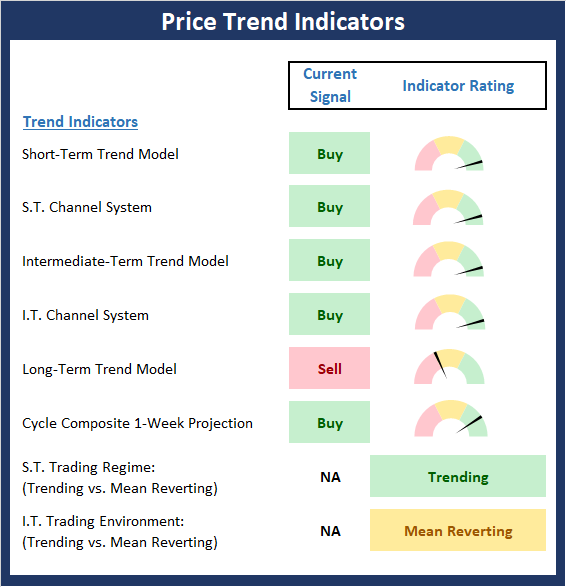
NOT INDIVIDUAL INVESTMENT ADVICE.
View Trend Indicator Board Online
The State of Internal Momentum
Next, we analyze the "oomph" behind the current trend via our group of market momentum indicators/models.
It is also positive that the Momentum Board is almost universally green at the present time. Also note that with no fewer than three breadth thrust buy signals firing last week, the historical return of the S&P 500 given the current readings of the momentum board has jumped from 12.25% to 21.16%. The bottom line is simple, this board suggests that there is indeed some "oomph" behind the rally.
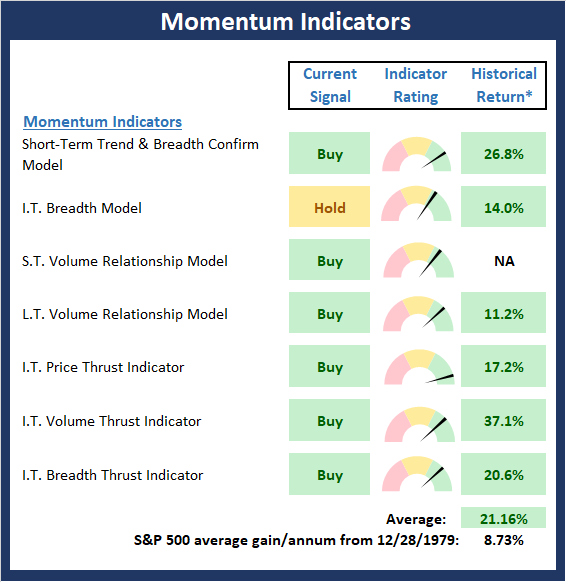
* Source: Ned Davis Research (NDR) as of the date of publication. Historical returns are hypothetical average annual performances calculated by NDR. Past performances do not guarantee future results or profitability - NOT INDIVIDUAL INVESTMENT ADVICE.
View Momentum Indicator Board Online
Early Warning Signals
Once we have identified the current environment, the state of the trend, and the degree of momentum behind the move, we then review the potential for a counter-trend move to begin. This batch of indicators is designed to suggest when the table is set for the trend to "go the other way."
The Early Warning board continues to favor the bears. However, it is important to keep in mind that when the bulls get on a roll, stocks can get overbought and stay overbought for extended periods of time.
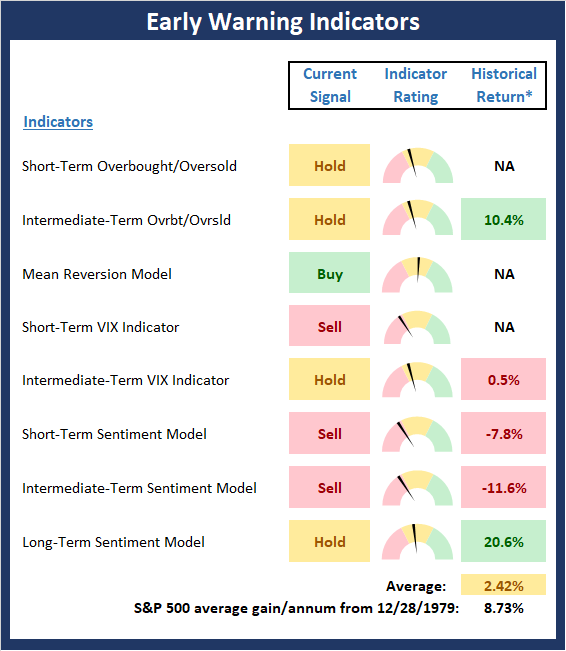
* Source: Ned Davis Research (NDR) as of the date of publication. Historical returns are hypothetical average annual performances calculated by NDR. Past performances do not guarantee future results or profitability - NOT INDIVIDUAL INVESTMENT ADVICE.
View Early Warning Indicator Board Online
Thought For The Day:
There is thy gold, worse poison to men's souls -Shakespeare
Wishing you green screens and all the best for a great day,

David D. Moenning
Founder, Chief Investment Officer
Heritage Capital Research
Disclosures
At the time of publication, Mr. Moenning held long positions in the following securities mentioned: IWM, MDY - Note that positions may change at any time.
Leading Indicators Model: A group of indicators that have historically shown tendencies to lead the market at major turning points.
Intermediate-Term Market Model: A composite model (model of models) focused on trend and momentum indicators which has been designed to provide identify intermediate-term trading opportunities.
Risk/Reward Model: A model-of-models intended to provide an overall view of the state of the risk/reward environment. The model includes tape, monetary, and sentiment indicators as well as 7 big-picture market model readings.
Desert Island Model: If I was stranded on a desert island with access to only one market model to manage money with, this would be the model. The model is a comprehensive model-of-models comprised of trend, momentum, mean reversion, economic, monetary, sentiment, and factor-based indicators/models.
External Factors Model: A model-of-models designed to provide a reading on the "macro state" of the market environment. The model is comprised of indicators/models in the areas of various index yields, industrial production, investors sentiment, and historic volatility.
Short-Term Trend-and-Breadth Signal Explained: History shows the most reliable market moves tend to occur when the breadth indices are in gear with the major market averages. When the breadth measures diverge, investors should take note that a trend reversal may be at hand. This indicator incorporates NDR's All-Cap Dollar Weighted Equity Series and A/D Line. From 1998, when the A/D line is above its 5-day smoothing and the All-Cap Equal Weighted Equity Series is above its 25-day smoothing, the equity index has gained at a rate of +32.5% per year. When one of the indicators is above its smoothing, the equity index has gained at a rate of +13.3% per year. And when both are below, the equity index has lost +23.6% per year.
Channel Breakout System Explained: The short-term and intermediate-term Channel Breakout Systems are modified versions of the Donchian Channel indicator. According to Wikipedia, "The Donchian channel is an indicator used in market trading developed by Richard Donchian. It is formed by taking the highest high and the lowest low of the last n periods. The area between the high and the low is the channel for the period chosen."
Intermediate-Term Trend-and-Breadth Signal Explained: This indicator incorporates NDR's All-Cap Dollar Weighted Equity Series and A/D Line. From 1998, when the A/D line is above its 45-day smoothing and the All-Cap Equal Weighted Equity Series is above its 45-day smoothing, the equity index has gained at a rate of +17.6% per year. When one of the indicators is above its smoothing, the equity index has gained at a rate of +6.5% per year. And when both are below, the equity index has lost -1.3% per year.
Cycle Composite Projections: The cycle composite combines the 1-year Seasonal, 4-year Presidential, and 10-year Decennial cycles. The indicator reading shown uses the cycle projection for the upcoming week.
Trading Mode Indicator: This indicator attempts to identify whether the current trading environment is "trending" or "mean reverting." The indicator takes the composite reading of the Efficiency Ratio, the Average Correlation Coefficient, and Trend Strength models.
Volume Relationship Models: These models review the relationship between "supply" and "demand" volume over the short- and intermediate-term time frames.
Price Thrust Model Explained: This indicator measures the 3-day rate of change of the Value Line Composite relative to the standard deviation of the 30-day average. When the Value Line's 3-day rate of change have moved above 0.5 standard deviation of the 30-day average ROC, a "thrust" occurs and since 2000, the Value Line Composite has gained ground at a rate of +20.6% per year. When the indicator is below 0.5 standard deviation of the 30-day, the Value Line has lost ground at a rate of -10.0% per year. And when neutral, the Value Line has gained at a rate of +5.26% per year.
Volume Thrust Model Explained: This indicator uses NASDAQ volume data to indicate bullish and bearish conditions for the NASDAQ Composite Index. The indicator plots the ratio of the 10-day total of NASDAQ daily advancing volume (i.e., the total volume traded in stocks which rose in price each day) to the 10-day total of daily declining volume (volume traded in stocks which fell each day). This ratio indicates when advancing stocks are attracting the majority of the volume (readings above 1.0) and when declining stocks are seeing the heaviest trading (readings below 1.0). This indicator thus supports the case that a rising market supported by heavier volume in the advancing issues tends to be the most bullish condition, while a declining market with downside volume dominating confirms bearish conditions. When in a positive mode, the NASDAQ Composite has gained at a rate of +38.3% per year, When neutral, the NASDAQ has gained at a rate of +13.3% per year. And when negative, the NASDAQ has lost at a rate of -15.269% per year.
Breadth Thrust Model Explained: This indicator uses the number of NASDAQ-listed stocks advancing and declining to indicate bullish or bearish breadth conditions for the NASDAQ Composite. The indicator plots the ratio of the 10-day total of the number of stocks rising on the NASDAQ each day to the 10-day total of the number of stocks declining each day. Using 10-day totals smooths the random daily fluctuations and gives indications on an intermediate-term basis. As expected, the NASDAQ Composite performs much better when the 10-day A/D ratio is high (strong breadth) and worse when the indicator is in its lower mode (weak breadth). The most bullish conditions for the NASDAQ when the 10-day A/D indicator is not only high, but has recently posted an extreme high reading and thus indicated a thrust of upside momentum. Bearish conditions are confirmed when the indicator is low and has recently signaled a downside breadth thrust. In positive mode, the NASDAQ has gained at a rate of +22.1% per year since 1981. In a neutral mode, the NASDAQ has gained at a rate of +14.5% per year. And when in a negative mode, the NASDAQ has lost at a rate of -6.4% per year.
Short-Term Overbought/sold Indicator: This indicator is the current reading of the 14,1,3 stochastic oscillator. When the oscillator is above 80 and the %K is above the %D, the indicator gives an overbought reading. Conversely, when the oscillator is below 20 and %K is below its %D, the indicator is oversold.
Intermediate-Term Overbought/sold Indicator: This indicator is a 40-day RSI reading. When above 57.5, the indicator is considered overbought and wnen below 45 it is oversold.
Mean Reversion Model: This is a diffusion model consisting of five indicators that can produce buy and sell signals based on overbought/sold conditions.
VIX Indicator: This indicators looks at the current reading of the VIX relative to standard deviation bands. When the indicator reaches an extreme reading in either direction, it is an indication that a market trend could reverse in the near-term.
Short-Term Sentiment Indicator: This is a model-of-models composed of 18 independent sentiment indicators designed to indicate when market sentiment has reached an extreme from a short-term perspective. Historical analysis indicates that the stock market's best gains come after an environment has become extremely negative from a sentiment standpoint. Conversely, when sentiment becomes extremely positive, market returns have been subpar.
Intermediate-Term Sentiment Indicator: This is a model-of-models composed of 7 independent sentiment indicators designed to indicate when market sentiment has reached an extreme from a intermediate-term perspective. Historical analysis indicates that the stock market's best gains come after an environment has become extremely negative from a sentiment standpoint. Conversely, when sentiment becomes extremely positive, market returns have been subpar.
Long-Term Sentiment Indicator: This is a model-of-models composed of 6 independent sentiment indicators designed to indicate when market sentiment has reached an extreme from a long-term perspective. Historical analysis indicates that the stock market's best gains come after an environment has become extremely negative from a sentiment standpoint. Conversely, when sentiment becomes extremely positive, market returns have been subpar.
Absolute Monetary Model Explained: The popular cliche, "Don't fight the Fed" is really a testament to the profound impact that interest rates and Fed policy have on the market. It is a proven fact that monetary conditions are one of the most powerful influences on the direction of stock prices. The Absolute Monetary Model looks at the current level of interest rates relative to historical levels and Fed policy.
Relative Monetary Model Explained: The "relative" monetary model looks at monetary indicators relative to recent levels as well as rates of change and Fed Policy.
Economic Model Explained: During the middle of bull and bear markets, understanding the overall health of the economy and how it impacts the stock market is one of the few truly logical aspects of the stock market. When our Economic model sports a "positive" reading, history (beginning in 1965) shows that stocks enjoy returns in excess of 21% per year. Yet, when the model's reading falls into the "negative" zone, the S&P has lost nearly -25% per year. However, it is vital to understand that there are times when good economic news is actually bad for stocks and vice versa. Thus, the Economic model can help investors stay in tune with where we are in the overall economic cycle.
Inflation Model Explained: They say that "the tape tells all." However, one of the best "big picture" indicators of what the market is expected to do next is inflation. Simply put, since 1962, when the model indicates that inflationary pressures are strong, stocks have lost ground. Yet, when inflationary pressures are low, the S&P 500 has gained ground at a rate in excess of 13%. The bottom line is inflation is one of the primary drivers of stock market returns.
Valuation Model Explained: If you want to get analysts really riled up, you need only to begin a discussion of market valuation. While the question of whether stocks are overvalued or undervalued appears to be a simple one, the subject is actually extremely complex. To simplify the subject dramatically, investors must first determine if they should focus on relative valuation (which include the current level of interest rates) or absolute valuation measures (the more traditional readings of Price/Earnings, Price/Dividend, and Price/Book Value). We believe that it is important to recognize that environments change. And as such, the market's focus and corresponding view of valuations are likely to change as well. Thus, we depend on our Valuation Models to help us keep our eye on the ball.
Disclosures
NOT INVESTMENT ADVICE. The opinions and forecasts expressed herein are those of Mr. David Moenning and Heritage Capital Research and may not actually come to pass. The opinions and viewpoints regarding the future of the markets should not be construed as recommendations. The analysis and information in this report is for informational purposes only. No part of the material presented in this report is intended as an investment recommendation or investment advice. Neither the information nor any opinion expressed constitutes a solicitation to purchase or sell securities or any investment program.
Any investment decisions must in all cases be made by the reader or by his or her investment adviser. Do NOT ever purchase any security without doing sufficient research. There is no guarantee that the investment objectives outlined will actually come to pass. All opinions expressed herein are subject to change without notice. Neither the editor, employees, nor any of their affiliates shall have any liability for any loss sustained by anyone who has relied on the information provided.
Mr. Moenning of Heritage Capital Research is an investment adviser representative of Eastsound Capital Advisors, LLC, a registered investment advisor. The adviser may not transact business in states where it is not appropriately registered, excluded or exempted from registration. Individualized responses to persons that involve either the effecting of transaction in securities, or the rendering of personalized investment advice for compensation, will not be made without registration or exemption.
Mr. Moenning and Heritage Capital Research may at times have positions in the securities referred to and may make purchases or sales of these securities while publications are in circulation. Positions may change at any time.
The analysis provided is based on both technical and fundamental research and is provided "as is" without warranty of any kind, either expressed or implied. Although the information contained is derived from sources which are believed to be reliable, they cannot be guaranteed.
The author neither endorses nor warrants the content of this site, any embedded advertisement, or any linked resource. The author or his managed funds may hold either long or short positions in the referenced securities. Republication rights must be expressly granted by author in writing.
Investments in equities carry an inherent element of risk including the potential for significant loss of principal. Past performance is not an indication of future results.

